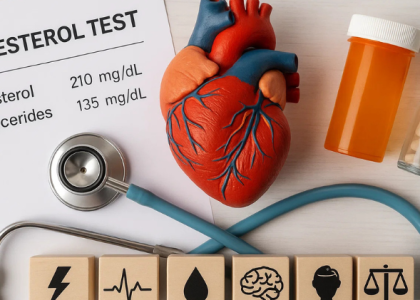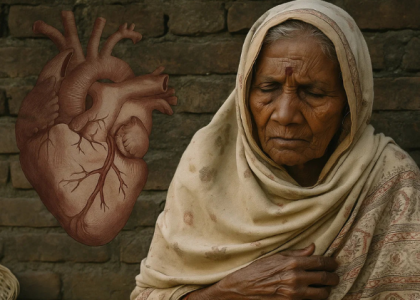Have you been putting off that heart checkup? You’re not alone. Many South Asian women delay getting important heart tests, even when they might need them most. Let’s talk about why this happens and how we can change it – together.
Family First: Our Strength and Our Challenge
As South Asian women, we take pride in putting our families first. Our role as caregivers is deeply valued in our culture. We make sure everyone has eaten before we sit down to eat. We schedule doctor’s appointments for our children, husbands, and parents – but often forget about ourselves.
Meera, a 45-year-old mother from Delhi now living in America, shares: “I was having chest pain for months, but my son had exams, my mother-in-law needed care, and my husband was busy at work. How could I take time for myself when everyone needed me?”
This “family first” mindset is beautiful, but it can sometimes put our own health at risk. Remember, taking care of your health IS taking care of your family. If you’re not well, how can you care for those you love?
“I’m Too Young For Heart Problems”
Many South Asian women believe they’re too young to worry about heart disease. We think, “Heart problems are for older people” or “Women don’t get heart attacks.”
The truth is that South Asians develop heart disease up to 10 years earlier than other groups [1]. This means that waiting until you’re older could be waiting too long.
Priya, 38, was shocked when her doctor suggested a heart checkup. “I thought he was being extra cautious. I eat vegetarian food and I’m not overweight. I never imagined I could be at risk.”
The Embarrassment Factor
Let’s be honest – many of us feel embarrassed about discussing our health concerns. We worry about what others will think. Will they judge us? Will they think we’re weak or complaining too much?
Some women feel shy about tests that might require removing clothing or being examined by male doctors. Others worry about their weight being discussed or feel uncomfortable talking about symptoms like fatigue or chest pain.
This embarrassment can lead us to minimize our symptoms or avoid medical appointments altogether.
“What Will People Say?”
In our community, there can be stigma around health issues. We worry about what relatives and friends might say if they learn we have health problems. Will they see it as a flaw? Will it affect how people see our family?
This concern about “log kya kahenge” (what will people say) can keep us from seeking the care we need. But your health is personal, and getting tested is a sign of strength, not weakness.
Fear of Bad News
Sometimes, we avoid tests because we’re afraid of what we might learn. It can feel safer not to know. But early detection saves lives, especially with heart disease.
Anjali put off her heart test for years. “I was terrified they would find something serious. But when I finally went, they caught my high blood pressure early, and now it’s under control with simple medication. I wish I hadn’t waited so long.”
Financial and Time Concerns
Many South Asian women worry about the cost of heart tests or taking time away from work and family responsibilities. These practical concerns are real, but there are often solutions available.
Language and Cultural Barriers
For some women, especially first-generation immigrants, unfamiliarity with the healthcare system and language barriers make seeking care intimidating. Not understanding medical terms or being unable to express symptoms clearly can be frustrating and discouraging.
Simple Steps to Make Heart Testing Easier
If these barriers sound familiar, here are some practical tips to help:
1. Go with a friend
Ask a friend or family member to accompany you to your appointment. Having someone supportive beside you can make a big difference. Try saying, “Sunita, can you come with me for my heart test next week? I’d feel more comfortable with you there.”
2. Start with one test
You don’t need to do everything at once. Ask your doctor, “Can we start with just one basic test?” Once you’ve taken that first step, the next ones become easier.
3. Find a female doctor if that makes you comfortable
If you feel more at ease with a female physician, ask for one. Many clinics can accommodate this preference. “I’d prefer to see a female doctor for my heart checkup” is a completely reasonable request.
4. Make it a family affair
Turn health into a family priority. Say to your spouse or children, “I’ve scheduled heart tests for both of us next month. Our family needs us to stay healthy.”
5. Bring a translator if needed
If English isn’t your first language, bring someone who can translate, or ask the medical facility if they provide translation services.
6. Schedule during quiet family times
Plan your appointment during school hours or when other family members can handle responsibilities at home.
7. Ask about costs upfront
Many clinics offer payment plans or sliding scales. Don’t be afraid to ask, “Can you tell me about the cost of this test and if there are any assistance programs?”
8. Remind yourself why it matters
When you feel like canceling, remember your “why.” Maybe it’s “I want to see my grandchildren grow up” or “My family needs me to be healthy.”
Words You Can Use
Not sure how to bring up heart tests with your doctor or family? Try these phrases:
- “Doctor, my family has a history of heart problems. What tests would you recommend for someone like me?”
- “I’ve been feeling more tired lately. Could this be related to my heart?”
- “Amma, I learned about a heart test called a Calcium Score. Can we both get it done together?”
- “Beta, I’m going for my heart checkup tomorrow so I can stay healthy for you. Can you help me prepare dinner tonight?”
Remember
You take care of your family’s hearts every day – with your love, your cooking, your support. Your heart deserves the same care and attention.
Taking steps to check your heart health isn’t selfish – it’s one of the most loving things you can do for your family. Because they need you to be around for a long, long time.
As we say in our community, a healthy mother means a healthy home. Your heart matters – to you and to everyone who loves you.




